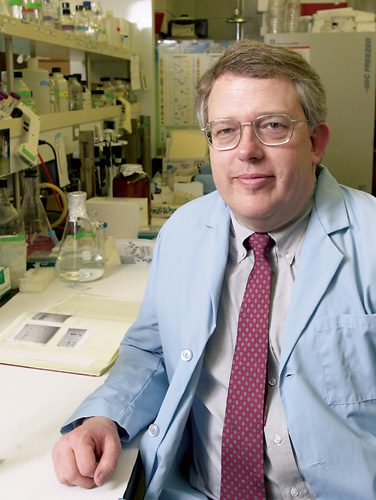By Stephanie Tripp
With a backpack stuffed full of research tools and a laptop computer, Paul R. Thomas, a BYU English professor, enters historic libraries in Wales, Scotland, France, Switzerland, England, and the United States to peruse manuscripts like Hengwrt, Morgan, and Ellesmere.
Thomas is seeking to uncover clues in a mystery that began about 1343 when a man, the son of a London vintner, was born. This man, a “Knight of the Shire” and diplomat to Flanders, France, and Italy, wrote a series of tales that detailed a pilgrimage of 30 travelers telling stories to and from their destination, Canterbury. Today, this work is known as the Canterbury Tales.
The mystery escalated when this man, poet Geoffrey Chaucer, died in 1400. Chaucer did not live long enough to finish all the tales projected in his General Prologue to the Canterbury Tales. Instead, he left behind fragments of tales in no apparent order. The fragments resulted in 84 different 15th-century manuscripts of Chaucer’s tales and three later-printed editions with differing orders and contents.
Centuries later, Thomas and other Chaucerian scholars have started an effort to solve the mystery–which of these 87 witnesses is the closest to Chaucer’s original poems? To find an answer to this question, Thomas joined the internationalCanterbury Tales Project in July 1994. The project involves transcribing available manuscripts of theCanterbury Tales onto software and placing them on CD-ROM, making possible comparisons of the various manuscripts through hypertext technology.
The ultimate goal of the project is “to come as close as possible to really true readings of Chaucer, rather than readings that scribes have made up,” Thomas said.
Comparing typed transcriptions with the original manuscripts is the reason for Thomas’s trip to English and U.S. libraries this summer and fall.
BYU is the only university from the United States participating in the transcriptions and collations. Other universities involved in transcribing include Oxford University, the University of SheYeld, and De Montfort University.
The project has separated the tales into the 10 fragments long studied by scholars. BYU’s main contribution is Fragment 7, which includes the “Shipman’s Tale,” the “Prioress’ Tale,” the “Tale of Sir Thopas,” the “Tale of Melibee,” the “Monk’s Tale,” and the “Nun’s Priest’s Tale.” The CD-ROMs containing these tales will be published by Cambridge University Press, and the first, on the “Nun’s Priest’s Tale,” is expected to be released in the summer of 1998.
“The beauty of this work is there is nothing guessed about and nothing abbreviated,” Thomas said. “The manuscript’s text is all put down exactly as it’s there, and it’s checked and checked and checked.”
Transcribing and checking the text of Fragment 7 is the main task of the BYU team. At the beginning of collation, a base text is created. “We have made our best estimate about what would be the oldest, closest-to-Chaucer text in each tale. That’s what we call the base text,” Thomas said.
The base text of a tale and all of the variations from the manuscripts that include that tale are typed into the computer. The transcriptions are taken from photocopies of microfilm of rotographs (1920s photocopy technology) of the original manuscripts. Then all of the manuscripts are collated together and compared to the base text through a computer program called Collate, developed specifically for the project. Each manuscript is compared line by line and word by word to note the variations and similarities of the differing texts, Thomas said.
Along with the collated manuscripts, the CD-ROM will include a digitized image of the text of each tale from each manuscript. The transcriptions will be available both in unregularized form–preserving all original spellings–and regularized form, enabling substantive comparison of readings across the various manuscripts.
“Nothing quite like this has ever been done, and this is all being done first by student and computer power,” Thomas said.
A team of students are helping Thomas with the project and have transcribed a little less than half of the approximately 55 manuscripts for Fragment 7. “We have a lot of work ahead of us,” said Melissa Gallup, a senior from Santa Rosa, Calif., studying English. Transcribing one tale from one manuscript can take from six to 15 hours depending on the quality of the copy and the length of the tale.
Although much remains to be done, the end is in sight for BYU’s first contribution to the project. The conclusion of the entire project, however, is estimated to be about eight years away. The directors of the Canterbury Tales Project hope to have all the fragments on CD-ROM and full transcriptions of at least the earliest six manuscripts. “When that’s done, it will be a vast collection on electronic text of Chaucer scholarship,” said Darin Merrill, a graduate student of medieval literature from Orem.
Thomas’s studies of Chaucer began when he was a student at BYU and continued through his master’s thesis and doctoral work. He is the producer and codirector of Chaucer Studio, an organization that provides cassettes of Old English, Middle English, Old Norse, and Old French readings. Recordings of Chaucer’s works, other tales, language pronunciation, and medieval music are provided by the studio. For information about the Chaucer Studio, contact Thomas at paul_thomas@byu.edu or through the Department of English, BYU, Provo, Utah 84602-6218.









